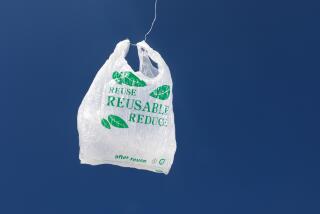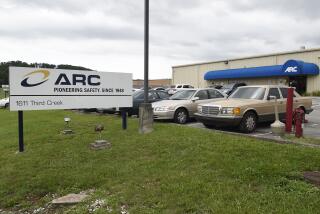Side Air Bags and Kids: The Jury Is Still Out
- Share via
Question: My car has side air bags, which worries me when my 9-year-old daughter rides in the back seat. The shoulder belt pulls her toward the door and the air bag, and when she falls asleep, her head slumps into the door.
How dangerous are side air bags? Have there been any deaths or serious injuries from them? How can I protect my child, who weighs 54 pounds and refuses to ride in a booster seat?
--J.M.H., Pacific Palisades
Answer: Although there have been no reported deaths or serious injuries involving side air bags, the National Highway Traffic Safety Administration has issued an advisory about the potential risk of injury to children who are improperly restrained near side air bags.
“Children who are seated in close proximity to a side air bag may be at risk of serious or fatal injury, especially if the child’s head, neck or chest is in close proximity to the air bag at the time of deployment,” the agency cautioned last fall.
While the general rule for front air bags is to keep at least 10 inches from the bag, NHTSA does not specify how far a child or adult should be from a side air bag.
In its advisory, NHTSA asked auto makers to ship new vehicles to dealers with their side air bags deactivated, unless the manufacturer has determined that they pose no significant risk to children, said Liz Neblett, an agency spokeswoman.
The agency further requested that dealers comply if owners of older vehicles ask that their side air bags be deactivated.
But not all auto makers have followed the advisory, which is only a recommendation and not enforceable.
“I contacted Mercedes, and they refused to deactivate the air bags on my ML320 sport-utility vehicle,” reader J.M.H. said. Instead, she said, the company sent her a letter recommending that “occupants, especially children, should never lean their heads in the area of the door where the air bag inflates. This could result in serious injuries or death should the air bag be triggered. Always sit upright, properly use the seat belts, and use an appropriately sized infant- or child-restraint system for all children 12 and under.”
Mercedes-Benz spokesman Jim Resnick confirmed that the auto maker has chosen to disregard NHTSA’s recommendations, noting: “Based on our safety tests . . . we believe the side air bags provide an excellent measure of safety for both adults and children.”
The benefits of side air bags far outweigh any risks, Resnick said.
Rear side air bags in Mercedes vehicles are smaller than front-seat bags and deploy “less aggressively,” Resnick said. The bag’s deployment reach when inflated is about 3 inches, shallower than the front air bags. In addition, all Mercedes cars have “dual-threshold” bags that regulate the speed or force with which they deploy, depending on the severity of the impact.
“We’re keeping a database of how many customers have asked for the bags to be deactivated,” Resnick said. “There’s only been a handful across the country.” If there is a surge in requests, he said, the auto maker might revisit the issue.
*
In our reader’s case, he said, the youngster will be protected if she is properly restrained in either a booster seat or by an adult seat belt.
At 54 pounds, the girl should use a booster seat, according to the weight range recommended by the National Safe Kids Campaign. The Washington-based child safety organization urges parents to use boosters for youngsters who weigh 40 to 80 pounds.
But getting a 9-year-old to ride in a booster is difficult, especially when such seats are decorated to appeal to much younger children, J.M.H. said.
“We often hear parents say that they don’t think their kids would go back into a booster seat, because they’ve already been out of it,” said Karen DiCapua, director of child passenger safety at the Safe Kids Campaign.
“We find that most children who should be in booster seats are not. Parents are placing them in the adult seat belts. The fear is that those children who are too small for the belts will be resting or sleeping against the side doors”--and thus risk being injured if the air bags deploy, she said.
NHTSA, auto makers and researchers at the Partners for Child Passenger Safety project, a joint effort by State Farm Insurance Cos. and Children’s Hospital of Philadelphia, continue to examine the risks involving side air bags. In light of studies in Europe that have found that side-impact crashes are particularly hazardous to children, researchers are seeking ways to improve child seat designs and otherwise enhance safety.
For now, the best way to protect your children in vehicles equipped with side air bags is to keep them properly restrained in a seat or belt system, or ask that the bags be deactivated if you fear your youngsters are at risk.
Your Mechanic
Mechanics are often unjustly blamed for the common problems consumers have with their cars. There are legions of heroes working in the garages of Southern California.
Do you have a story about a favorite mechanic you’d like to share?
Write to Ralph Vartabedian, Your Wheels, Business Section, Los Angeles Times, Times Mirror Square, Los Angeles, CA 90053. E-mail: ralph.vartabedian@latimes.com.
Please include your name, city and a daytime telephone number, as well as the mechanic’s name and the city, name and phone of his or her business.






